
Plaster Rock’s first settlers were Hezekiah Day and his two brothers, who arrived in 1881. Plaster Rock was incorporated as the Village of Plaster Rock on November 9, 1966. Hezekiah Day gave Plaster Rock its name based on the hill on the other side of the Tobique River – the rock is made up of gypsum, or plaster.
The second settlers, Mr. & Mrs. Henry Ridgewell, arrived in 1882. The third settler was a gentleman named David Roulston and his family. The first true native of Plaster Rock was Gideon Day.
Structures Around Town
As the settlement grew, new structures and amenities cropped up. The first school was built in 1901 at Pig’s Ear with Henry Ridgewell as its janitor. This school burned down, and in its place was constructed a store. The school was located over the store, but was later moved. One of the first teachers was Miss Gertrude Flanders. After she left, the two Page girls took charge of the school, followed by the Hart girls and later by Mrs. Beulah Beatty. After this school burned down, it was replaced by the Plaster Rock Superior School in 1917, with Miss Helen Robinson as the principal. In 1920, a piano was purchased for the school, and in 1936 Wiley Tomlinson was awarded the Beaverbrook Scholarship. The 1936 graduating class in the Superior School consisted of 15 pupils. Some of the graduates were Judge Tomlinson and Ralph Lloyd.
The Plaster Rock Superior School served the community until 1949, when it was destroyed by fire. It was replaced by the modern day Donald Fraser Memorial School for elementary grades. The Tobique Valley High School was built in 1947 to accommodate grades eight through twelve.
The first bridge, built in 1901, was a wooden covered bridge. This bridge was washed out in the spring freshet on April 17, 1934, and replaced with a new wooden bridge. In 1971, this bridge was torn down and a new concrete bridge was constructed down river a short distance.
As the town grew, more features were added. Wooden sidewalks were built in 1913 – concrete sidewalks took their place on Main Street in 1955. The Cenotaph, unveiled on September 28, 1928, was bought by subscription and a donation of $1,000 from the county council. The total cost was $1,946.50. In 1947, the names of those who died in World War II were engraved. The Tobique Valley Centennial Arena, opened in 1967, and the Plaster Rock Tourist Park opened in 1982.

Industry, Then and Now
Farming was the first occupation. Farmers raised pigs, cattle, hens and other animals for their own use. At this point in time, potatoes were not an important crop.
In winter, the men went to the woods and lumbered. In 1896, a lumber mill was built by Fred and Archie Hale; Donald Fraser later purchased it in 1901. The mill was located where the present Plaster Rock Lumber Corporation (formerly known as Fraser Paper Inc.) mill stands.
Shortly after the mill was completed, around 1900, James McNair, father of former Premier J.B. McNair, built a general store on the west side of the river. This was the town’s first commercial venture other than the mill. This store was later bought by Alfred Green, who ran it for some years and then sold it to the Farmer’s Cooperative Company.
The first dairy farm was constructed in 1910. It burnt in 1917 and was rebuilt the same year. There were 80 head of cattle in the old barn at the time, and 40 head burned in the fire.
The first garage was built in 1912 by Bert Flanders and was torn down in 1929. In 1936, Mr. Tilley took over the old Flanders garage. In 1938, Donald Fraser bought it from Mr. William Diamond; it was run by Marsten Company with Mac Wright as manager. The second garage was built in 1926 by Lem Hatheway. In 1939, the old Hatheway garage was torn down and a new one constructed.
The most popular meeting places in the early years were hotels. Mr. Wash Turner and family built a two-and-one-half story building that was used for a hotel and boarding house. Charley Beny came along around 1906, rented a large room in the front of the building and started a grocery store. After Mr. Beny became ill, the building was purchased by S.C. Campbell to be used as a clothing store.
The Queen Hotel was built in 1910 by Mr. Post. He rented it for 15 years and then sold it to Mr. Fraser, who turned it into a tenement building.
The community hall, or theater, was built in the spring of 1928 by Mr. Fraser. It seated approximately 450 people.
The first barber in Plaster Rock was a gentleman named Frank Johnston. Then along came Samuel Campbell in 1915, who had the first upstairs barber shop. Mr. Campbell also stocked the shelves with candy and light groceries. He also had tubs of ice cream and labeled it Campbell’s Ice Cream Parlor. William Parsons moved to Plaster Rock to receive his apprenticeship under Mr. Campbell, and his son Carl Parsons worked as a barber for many years within the town.
The shoemaker was once the independent craftsman of the town. The first shoemaker of Plaster Rock was Jack Powers. To follow were Russell Smythe, Victor Brown and Jim Harrington.

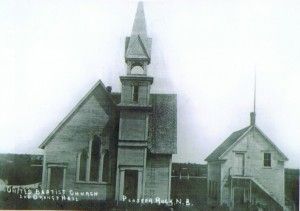
Early Churches
From 1898 to 1901, the Baptists of Plaster Rock worshiped at Linton Corner Church. After 1901, a room was reserved in the sawmill. Services were even held in the hotel office during the cold winter months. In 1908, the congregation celebrated the dedication of their new church. Disaster struck when both the parsonage and church were destroyed by fire in 1920 by sparks from the mill. Two years later, their second church celebrated its dedication at the present-day site. The first minister was Rev. Charles Sterling.
In 1904, Rev. Father Ryan began construction of the Roman Catholic Church, which was completed in 1907. Before its dedication, the congregation held regular Eucharistic services in the school. The lot and much of the lumber was donated by Donald Fraser. The first pastor of St. Thomas Acquinas was Rev. F.C. Ryan.
That same year, 1907, the first United Church of Canada was dedicated with a student minister, Mr. M.H. Manuel. Mr. Donald Fraser, a member of the church, donated two beautiful stained glass windows in the sanctuary. Prior to 1907, the congregation held regular services in the Fraser Company’s boarding house. The first minister was Rev. Louis J. King.
The Primitive Baptist Church was organized in 1913, and services were held at the home of Mr. & Mrs. William Post until a parcel of land was purchased from Mrs. John McDougall for $100. Mrs. McDougall was the eldest daughter of Hezekiah Day. The church was completed in 1914, with a new organ donated by Watts Cox. The first minister of the church was Rev. A. Hatfield. In 1980, after serious discussions led to a vote, they merged with the Free Will Baptist Association.
In 1927, St. George’s Anglican Church was dedicated by Canon W.J. Clarke, a well known and loved pastor on the Tobique. Before 1927, the Anglican services were held in the Orange Hall and in the Morecraft house. Rev. Foyster, Anglican Minister of New Denmark, conducted service until Rev. Wilde suggested building a church. He was unable to remain here to see his dream fulfilled, as he became sick and returned to England. Rev. W.J. Clarke, moved by Rev. Wilde’s idea, succeeded in building the structure.
The Pentecostal Church was first established in 1931, with its first pastor being Rev. W.J. Rolston. Since July 27, 1932, yearly conventions have been held here, bringing evangelists from many other cities. In 1998, a new church was constructed beside the previous church (which is now the private school), with Rev. Daniel McKillop as Minister. The church is now known as, Family Worship Centre. They are working on a new building located on the by-pass. This project has been ongoing since 2020.

Utilities and Services
Plaster Rockers were the only ones in a large area of the province that had electricity between 1929 and 1939, because the Frasers owned a private plant. John Bernier was the company electrician until 1928, when a diesel-powered generator was installed. In 1929, Mr. Theo Haddad was hired to take charge of this new system. This was only a six-hour-a-day service, from 6am to 12pm. In 1940, Mr. Fraser sold the power system to the New Brunswick Power Commission, which improved the system to a 24 hour service.
In 1904, there was telephone communication from Plaster Rock to Nictau.
Fire services were established around 1921, when the New Brunswick government built a system of look-out towers to help prevent the spread of forest fires. One was built on Mount Carleton, Tower Hill and another on Blue Bell Mountain. By 1970, all the towers had been closed. In 1974, a new fire hall and office were purchased. In 1998, after a new village garage was constructed, the old Village Garage was demolished and a new Fire Hall was constructed on that site in 1999.
The Royal Bank of Canada was built in 1927, with Mr. Stevenson as manager of the bank. Prior to this, business was carried out in the Turner Building. Mr. Fred Henderson came to be the first bank manager in 1919.
From 1877, a man named Mr. James Inman delivered mail once or twice a week for 30 years. During the winter months, Mr. Inman delivered the mail on horseback, in snowshoes or even on foot. His route was later taken over by Mr. Barney Armstrong. The first post mistress was Ida Dickinson in 1925, and George Lovelock took it over in 1927. The post office was burned in 1938 and the present post office was constructed in 1955.
Plaster Rock, as any other new community, needed law and order. Before the RCMP came along, the citizens assumed the responsibility to see that justice reigned. Before 1945, the law was enforced in the Plaster Rock area from the detachment in Perth-Andover. The first RCMP detachment in Plaster Rock was opened on June 1, 1945, with Constable Truman Trenouth in charge.
The first and second hospitals, which were destroyed by fire, were operated out of a boarding house. The hospital, Tobique Valley Hospital, was officially opened in January, 1957. The first doctor in Plaster Rock was Dr. Joe Coffin, who arrived in 1901. Dr. Coffin, who had one of the first automobiles in Plaster Rock, is believed to have delivered approximately 5,000 babies during his 50 years of practice. We currently have a health clinic in its place called, Tobique Valley Community Health Centre.
The Independent Order of the O.F. was organized in 1909 in the basement of the United Church. The first Orange Hall was built in 1915. The present I.O.O.F. hall was built by Howard Jakes and the Post boys in 1922.
The Canadian Pacific Railway was built in 1896 by John Stewart. It was built by hand labor, using picks, shovels, wheelbarrows and slush scrapers. The first train was fired by wood. The train only came to Plaster Rock when it wanted a load of plaster. John Stewart was president of the railroad. The railway was not sold to the C.P. Railway as commonly believed, but was leased for 99 years.
The Canadian National Railway was built through Plaster Rock in 1909. It was not until 1910 that the bridge was built. One train went from Edmundston to Plaster Rock, and another one went from Moncton to Plaster Rock.
Fraser Companies Ltd.
The Fraser name has been identified with logging on the Tobique River for over 100 years.
In 1895, Donald Fraser, Sr., the founder of Fraser Companies Limited, participated in organizing the Tobique Log Driving Company. The firm’s name at that time was Donald Fraser and Sons, incorporated in 1895, comprised of Donald Fraser Sr. and his two sons, Archibald and Donald. At this point, most of the logs cut on the Tobique were water driven to mills on the St. John River. In 1894, Donald Fraser and Sons had built a large sawmill in Fredericton called the Aberdeen Mill. This mill burnt in 1905 and was never rebuilt.
In 1900 they incorporated the Tobique Manufacturing Company Ltd., which in 1901 acquired the Hale Mill property including a sawmill on the site of the present mill. In 1908, the name of this firm was changed to Fraser Lumber Company. This company became one of the group of companies incorporated as Fraser Companies Limited in 1917. Today the mill is called Plaster Rock Lumber Corporation (formerly known as Fraser Paper Inc.).
Thus, the firm of Fraser has been operating sawmills on the Tobique River since 1900 and logging on this river as far back as 1895 or even earlier. In the intervening years they have operated several other mills, sawing both softwood and hardwood. The Plaster Rock mill has been in continuous operation up to the present.
Many varieties of lumber trees grow along the Tobique River, which include: pine, spruce, fir, poplar, cedar, tamarack, hemlock, maple and birch. Extensive forest fires in 1825, 1855, 1884, 1912, 1923 and 1933 have all had their impact on the nature of the forest which followed. The actual record since 1937 indicates the average area burned per year has been 750 acres.

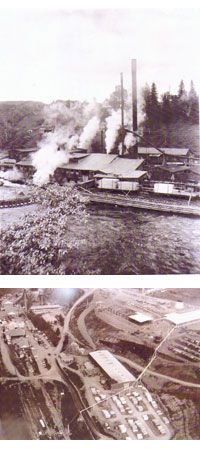

Plaster Rock’s Surrounding Areas
The Tobique, a small river, runs nearly the length of Victoria County. It begins in several streams, which form two streams, which unite at Nictau to form the one river. The Tobique empties into the St. John River. The Tobique has a mild climate with neither extremes of heat in summer nor cold in winter.
The first white man and woman to settle on the Tobique was William Campbell and his mother, who took up land at Arthurette. Soon following them was the family of James Giberson and the Browns. A few years later, Allan Reed and his family took up land above them on the opposite side of the river now known as Reed’s Island or St. Almo. Then came the Blues and Knowltons, who settled farther up the river near what is now Blue Mountain Bend. Then came the settlers of Plaster Rock and it was a steady growth from there.
In 1850, a plaster mill was built at Three Brooks by Thomas Edgar. The plaster was hauled from what is now Plaster Rock down the river on the ice. A few years later lumbering became so prominent that the mill at Three Brooks was changed to a lumber mill. The first saw mill on the Tobique was built at Caldwell Brook. In 1889 another saw mill was built at Arthurette by Stratten Brothers. This mill burned in 1904.
The first school outside of Plaster Rock was built in Arthurette in 1860. The first teacher was Sally Hutchinson. In 1870 a school was built at Three Brooks with the first teacher being Martha Linton. After that schools were built at Maple View, Sisson Ridge and Plaster Rock.
The first telephone line on the Tobique was built in 1890 and John Stewart was the main person in getting the line up. The first telephone was installed in a store at Red Rapids. The next telephone was installed at John Smith’s residence at Three Brooks.
The first bridge on the Tobique was built across the river in Arthurette in 1876. This was soon followed by one in Rowena which was torn down and replaced by one at Tobique Narrows. These were followed by bridges in Riley Brook and Plaster Rock.
Interesting Facts
– On March 7, 1874 records show that Messro Brimmer had been peddling liquor on the Tobique River and supplying jug taverns. During that winter, they were convicted for selling, contrary to the law, and fined $20 and cost.
– In 1918, Fraser bought the Arbuckle Mill site and built a shingle mill. This site had been used to crush the plaster hauled from town. It has been said that as many as 50 men worked there at one time.
– Mr. B.T. Marsten came to Plaster Rock to open a hardware store. He and Arthur Ridgewell operated an undertaking business in Marsten’s basement while he sold coffins overhead in the Ridgewell building. Mr. Marsten also amalgamated an insurance business with Jeff King. His hardware store still stands on Main Street.
– Plaster Rock once had the honor of sending one of its citizens, Vincent Shields, to the National League. He played baseball for the St. Louis Cardinals and the Philadelphia Phillies.
– The first Mayor of Plaster Rock was Don Gerrish.
Thus, the Tobique has increased in population and today Tobiquers have the District of Tobique Valley to be proud of.
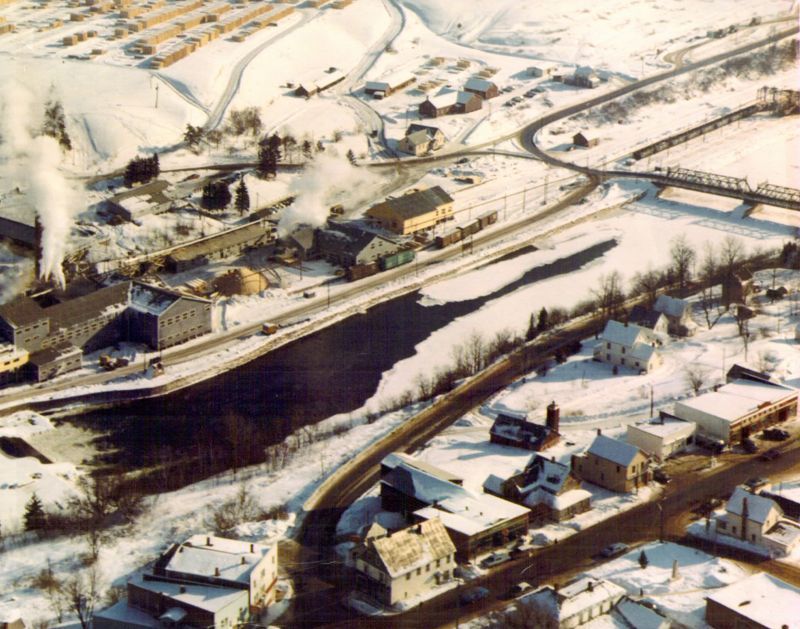
History of Riley Brook & Nictau
Riley Brook
The community of Riley Brook is said to be named after a man, Riley, who was drowned in the brook which now bears his name.
The brook enters the Tobique River across the road from the main part of community.

William Everett was the first settler at Riley Brook (Maybe 1860’s). The family came from England, when William was a lad of four years. It is presumed the family settled at or near Andover, as that is where William came from when he decided to seek his fortune on the Tobique. He had married Rebecca Ross and she bore him a family of four sons and six daughters.
In those early days, ship building was largely carried on in Saint John and the forests of New Brunswick were rich in heavy timber. William gathered up some men and for several years he lumbered some miles above Nictau possibly ten or twelve miles above Riley Brook towing his supplies with oxen from Andover in summer, by ice in winter. The lumber, pine and birch, was squared and floated to Saint John in rafts.
______________________________________________
- GeoNB. https://geonb.snb.ca/geonb/
- Mrs. John Everett for the Historical Society of New Brunswick, and a copy was kept by Mrs. Grace Flanders. The article was submitted to and published by a local newspaper, and the clipping kept in a scrapbook by Myrtle (McAskill) LeBel, and donated to the Plaster Rock Public School Library.
By 1898 Riley Brook was a lumbering settlement with 1 post office, 1 store, 2 hotels, 1 sawmill, 1 church and a population of 100.
Riley Brook Store, Pre-1906.
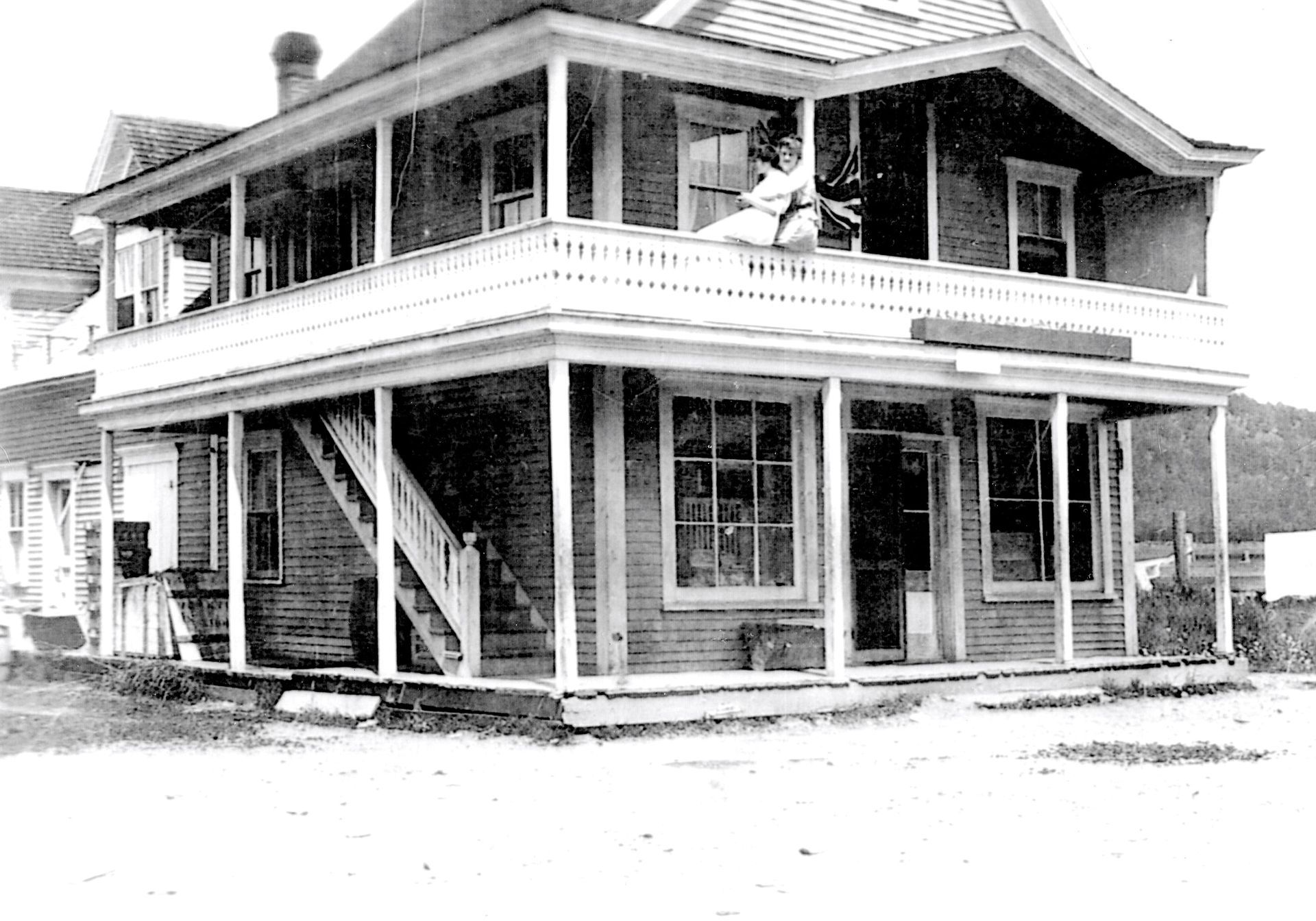
_______________________________________________
- Nb Provincial Archives. https://archives.gnb.ca/exhibits/communities/Details.aspx?culture=en-CA&community=3317
- Tobique Valley Genealogy & Local History Archives. Uncredited photo.
Riley Brook and the surrounding area was also a sportsman’s paradise.
The Tobique, since first known, was teeming with Atlantic salmon, the Serpentine branch being a famous spawning ground and its upper branches became an ideal sportsman locality, and Riley Brook headquarters for many of the guides employed; but sad to say the Beechwood dam on the St. John soon put an end to that lucrative industry on the Tobique.
Charles L. Barker, Outfitter.
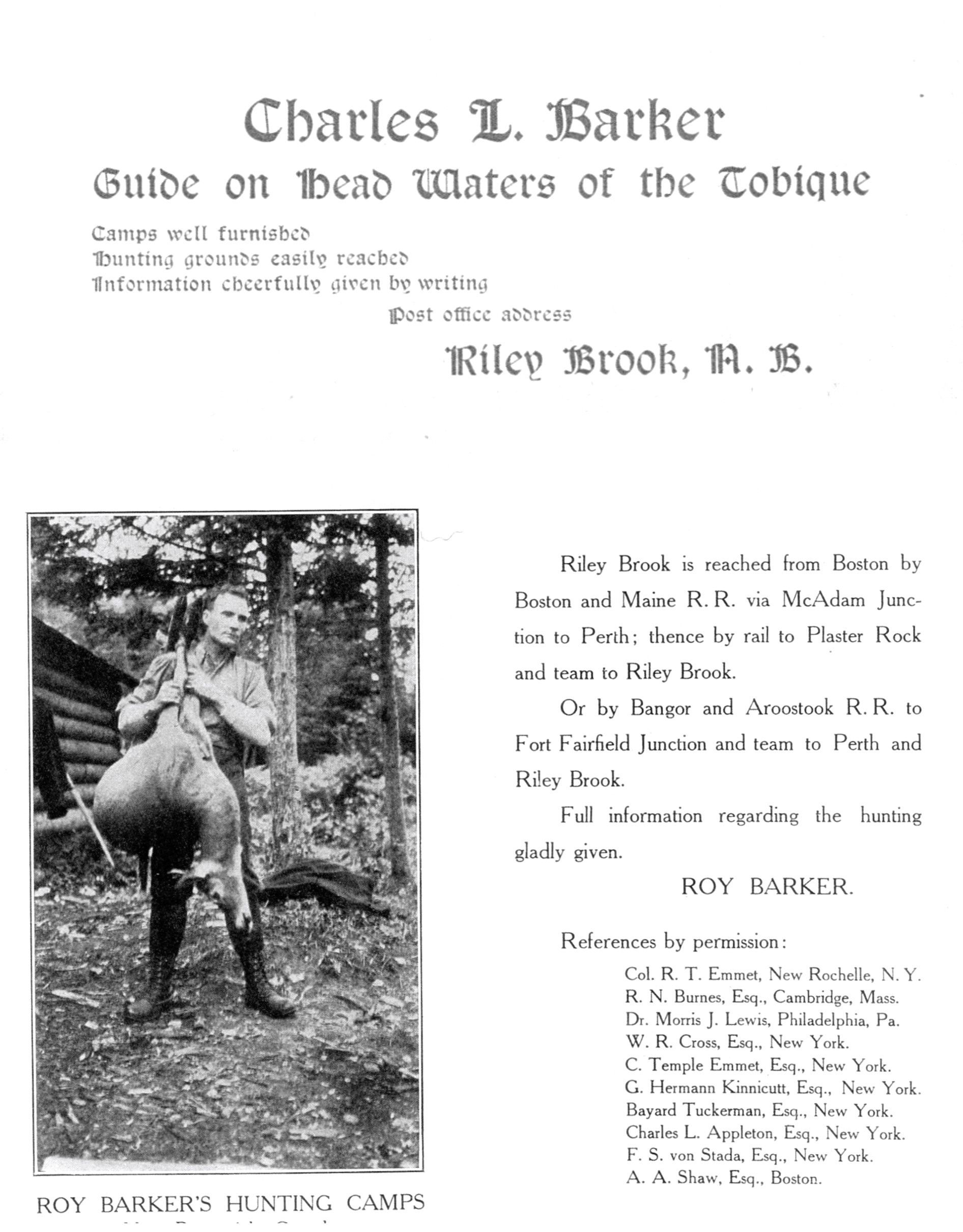
__________________________________________
- Mrs. John Everett for the Historical Society of New Brunswick, and a copy was kept by Mrs. Grace Flanders. The article was submitted to and published by a local newspaper, and the clipping kept in a scrapbook by Myrtle (McAskill) LeBel, and donated to the Plaster Rock Public School Library.
- Tobique Valley Genealogy and Local History Group. Photo album page.
Riley Brook Bridge 1907-1958
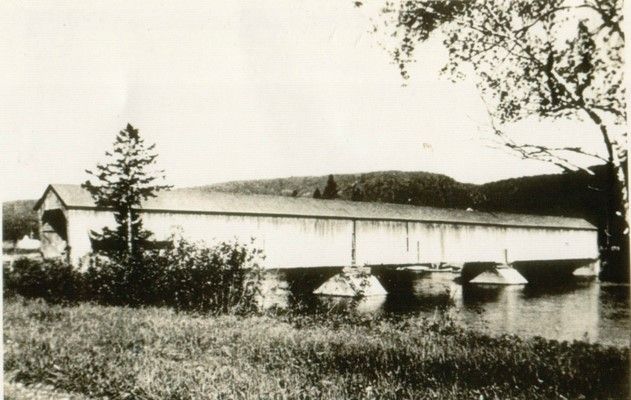
________________________________________
Uncredited photo.Tobique Valley Genealogy & Local History Archives. Plaster Rock Public School Library.
Water Wheel Riley Brook C1900.
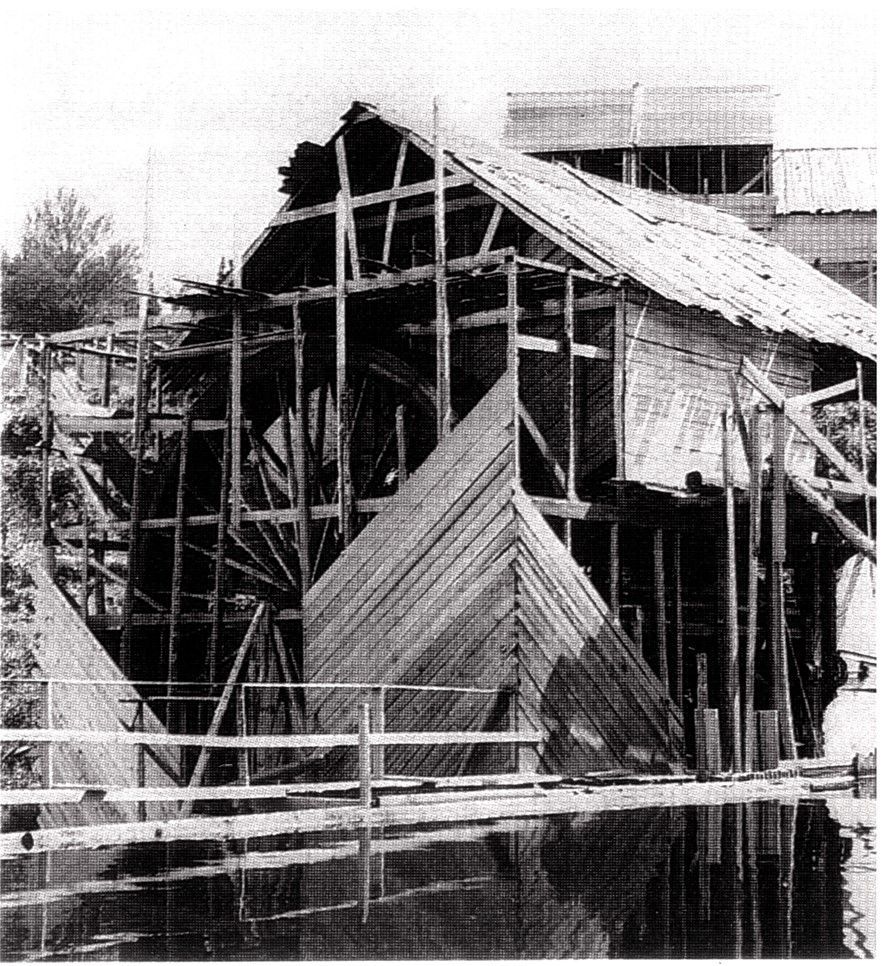
Nictau
Nictau was a farming settlement with a population of 20 by 1898 and had it’s own post office from 1887-1948.
Nictau was well known for two establishments, the Miller Hotel and Miller Canoes
The Miller Hotel
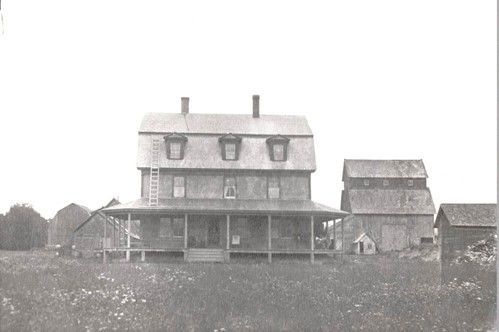
____________________________________________
- Uncredited photo.Tobique Valley Genealogy & Local History Archives. Plaster Rock Public School Library.
- Provincial Archives of New Brunswick. https://archives.gnb.ca/exhibits/communities/Details.aspx?culture=en-CA&community=2815
- Unattributed photo. TVGLHG Digital Archives. Plaster Rock Public Library.
William Henry Miller was married to Mary Jane MacDougall and had five children,
Victor, Jack, Pauline, Emma and Jean. William was a bad asthmatic who lived in Perth at that time.
The doctor advised him to move to the Tobique where the air was cleaner. He moved to Nictau and
built the Miller Hotel in 1908 at the very end of the dirt road. It was a large hip roofed building
constructed on the opposite side of the road from the Tobique River.”[1]
In 1925, the Miller Hotel had a special American guest.
The hotel register from October 19, 1925 shows an entry, on the second line, for “George “Babe” Ruth, New York City”.
From the register....
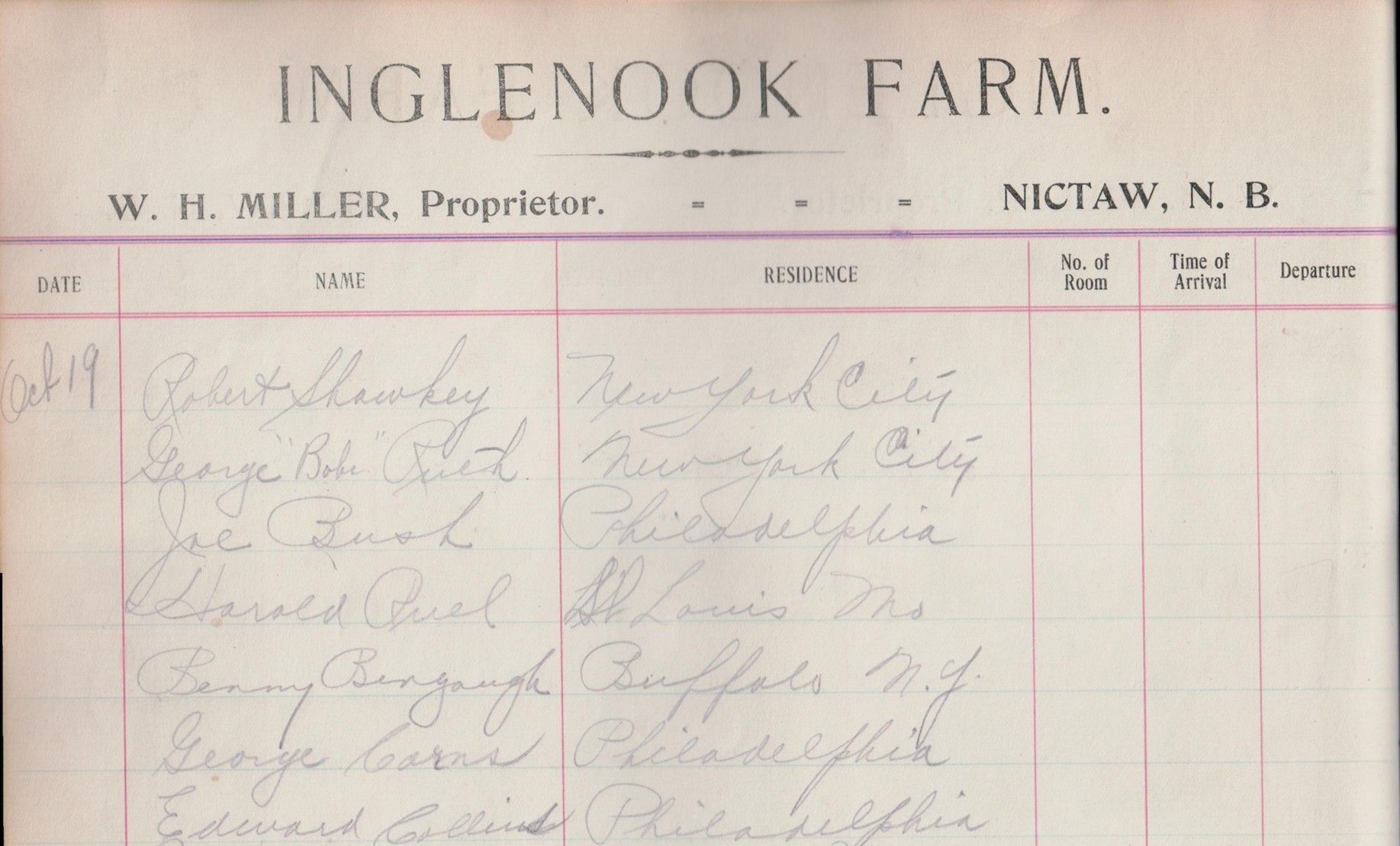
A Group Photo.

____________________________________________
- Interview with Wilma Miller January 27, 2009. TVGLHG Digital Archives. Plaster Rock Public School Library.
- Miller Hotel Register page, 1925. TVGLHG Digital Archives. Plaster Rock Public School Library.
- Unattributed photo. TVGLHG Digital Archives. Plaster Rock Public School Library.
Miller Canoes - 1925-2022
Miller Canoes has been operating since 1925 when it was founded by Vic Miller. Bill Miller, a third generation builder, ran the business until his death in 2022.
Bill tells the story of the Chestnut Ogilvy: "Mr. Chestnut was salmon fishing at the Ogilvy camp on the Tobique River in the late twenties or early thirties. Chestnut was admiring Ogilvy's Miller canoe and asked him where he got it? Jock said 'Vic Miller hewed this out wood with an axe up in Nictau.' Since it performed so well as a poling canoe, he asked Ogilvy to bring the canoe to Fredericton that fall. Lines were taken off it and it was put into production. The model was named after the Ogilvy. My grandfather did not get any credit for it, but he claims they didn't get it quite right. The original Miller model is still in use."
https://www.ottertooth.com/Canoe_pages/miller_canoe.htm
History of Birch Ridge & Arthurette
We easily recognize the place names of the communities of the Tobique, but before they came to be, this was the land of the Wolastoqiyik for thousands of years.
When we speak of the “first settlers/first communities on the Tobique”, we must be aware that we speak only of the “first non-indigenous” people to acquire land and start to build homes and communities.
Birch Ridge
Birch Ridge was settled in 1878 by John Robertson who was burnt out by the Saint John Fire of 1877. in 1898 Birch Ridge was a settlement with 1 church and a population of 100.
The first trees that John Robertson cut were birch and they grew on a ridge and so from this fact he named the place Birch Ridge.
The first post office (1880-1942) in Birch Ridge was kept by Thomas Knowles and the first mail carrier was Levi Campbell. He used a dog team.
The first school house was a log building and the first school master was John Stevenson. In 1888 the Episcopal Church, St. Bartholomew’s was started. It was finished and consecrated in 1890 by Bishop Kingdon. The first clergyman was Reverend Leo Hoyt. A Baptist church was also erected within the next few years with Reverend Charles Henderson as minister.
____________________________________________
- NB Archives. https://archives.gnb.ca/exhibits/communities/Details.aspx?culture=en-CA&community=328
- Pioneer Days of Birch Ridge. Emily Gallop. Tobique Valley Genealogy and Local History Group Archives. Plaster Rock Public School Library
- Pioneer Days of Birch Ridge. Emily Gallop. TVGLHG Archives. Plaster Rock Public School Library
Arthurette
The fledgling community of Arthurette was first identified as Campbell Settlement.
The community was later named after Arthuret in Cumbria, England by Arthur Hamilton-Gordon, 1st Baron Stanmore, who was lieutenant governor of New Brunswick from 1861 to 1866.
Arthurette was the first European community to be established on the Tobique River and Tamberlane Campbell and family were among the earliest settlers to the area. Tamberlanes’s father, Edward made two unsuccessful petitions of land in 1819 (500 acres on the Wapskehagen Stream) and 1824 (500 acres at the mouth of the Odell).
Three of Edward’s sons, Tamberlane, William and Alexander settled on the Tobique and were living in the area in 1851.
In 1866 Arthurette was a farming and lumbering community with about 95 resident families and by 1898 Arthurette was a flag station on the Tobique branch of the Canadian Pacific Railway and a settlement with 1 post office, 2 stores, 1 hotel, 2 churches and a population of 200.
____________________________________________
- NB Archives. https://archives.gnb.ca/exhibits/communities/Details.aspx?culture=en-CA&community=328
- Pioneer Days of Birch Ridge. Emily Gallop. Tobique Valley Genealogy and Local History Group Archives. Plaster Rock Public School Library
- Pioneer Days of Birch Ridge. Emily Gallop. TVGLHG Archives. Plaster Rock Public School Library
- Pioneer Days of Birch Ridge. Emily Gallop. TVGLHG Archives. Plaster Rock Public School Library
- NB Archives. https://archives.gnb.ca/exhibits/communities/Details.aspx?culture=en-CA&community=573
- Wikipedia. https://en.wikipedia.org/wiki/Arthurette,_New_Brunswick
- Tamberlalane, Ernest A. Clarke, 1981. TVGLHG Collection, Plaster Rock Public School Library
Sprague Bros. Blacksmith Shop, c 1890.
Sprague Brothers Blacksmith Shop, Arthurette. Rob Sprague, Frank Sprague, Fred Sprague, James Sprague, Fred Cronkite and Gilbert Cronkite all of Arthurette; Tommy Perey, Grand Fall [Grand Sault], 1890.
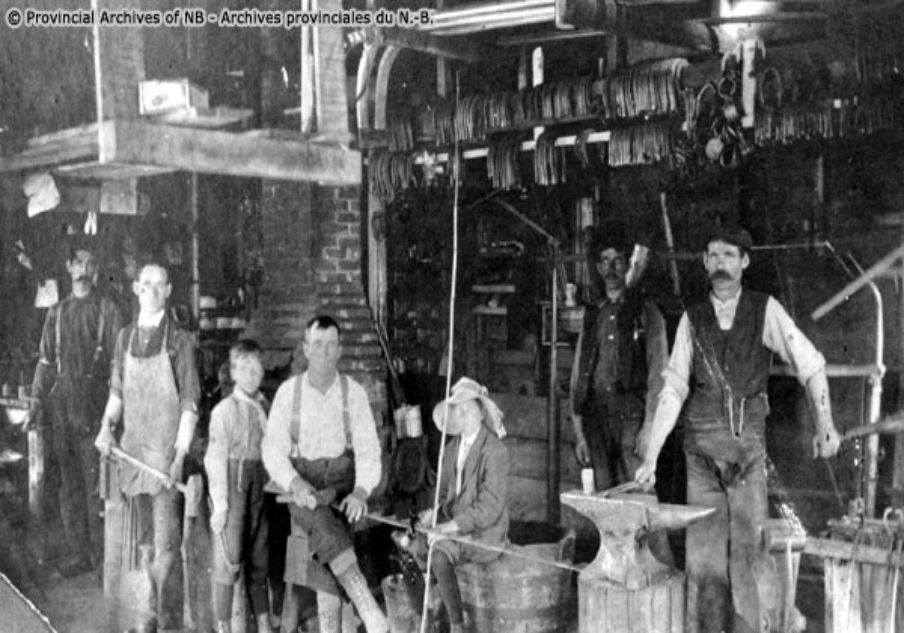
_____________________________________________
- Tamberlalane, Ernest A. Clarke, 1981. TVGLHG Collection, Plaster Rock Public SchoolLibrary
- NB Provincial Archives: https://archives.gnb.ca/Exhibits/Communities/Details.aspx?culture=en-CA&community=101
- NB Provincial Archives. https://archives.gnb.ca/exhibits/communities/Details.aspx?culture=en-CA&community=101
- PANB. https://archives.gnb.ca/Exhibits/HistoricalImages/Details.aspx?culture=en-CA&ImageID=P37-432
Arthurette Bridge during 1950 spring flood.
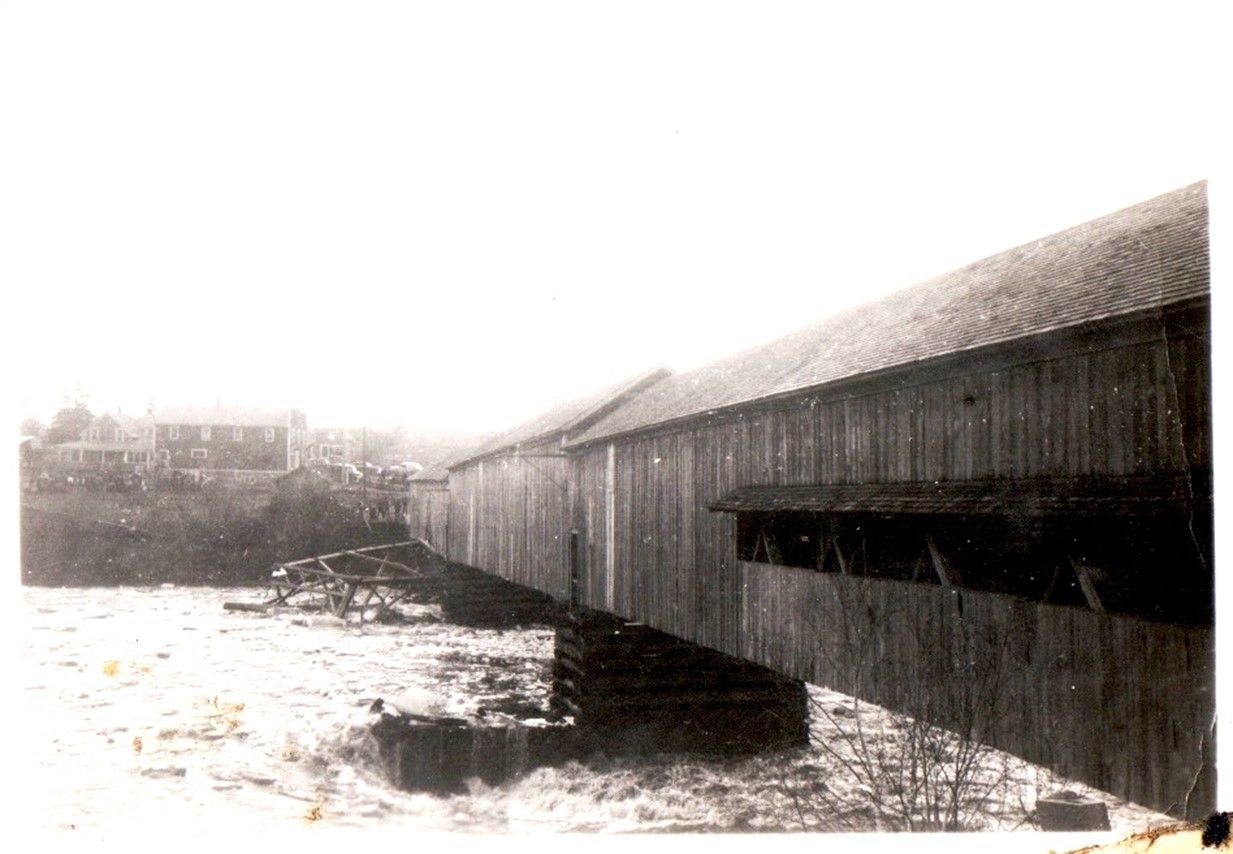
___________________________________
Tobique Valley Genealogy & Local History Group Digital Archives, Plaster Rock Public School Library
Unattributed photo. Tales of the Tobique Vol 1, edited by Leslie Clarke and Mark Glass 2008. Self published.
Arthurette Bridge, 1950.

The bridge collapse was the end result of the Plaster Rock trestle bridge washing out and colliding with the Arthurette bridge in the spring freshet of 1950.


